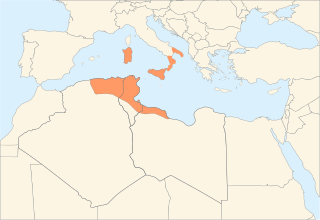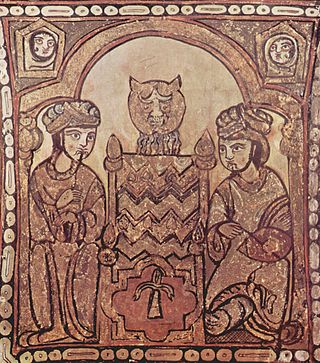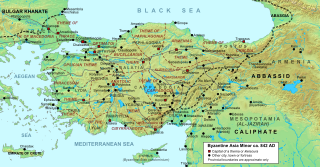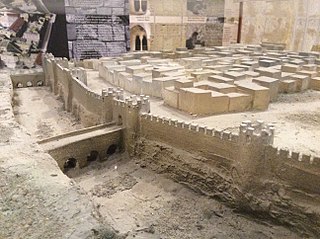
Year 902 (CMII) was a common year starting on Friday of the Julian calendar.

The Aghlabids were an Arab dynasty centered in Ifriqiya from 800 to 909 that conquered parts of Sicily, Southern Italy, and possibly Sardinia, nominally as vassals of the Abbasid Caliphate. The Aghlabids were from the Najdi tribe of Banu Tamim and adhered to the Mu'tazilite rationalist doctrine within Hanafi Sunni Islam, which they imposed as the state doctrine of Ifriqiya. They ruled until 909 when they were conquered by the new power of the Fatimids.

Abu Ishaq Ibrahim II ibn Ahmad was the Emir of Ifriqiya. He ruled from 875 until his abdication in 902. After the demise of his brother, Ibrahim was endorsed as emir where he took steps to improve safety in his domain and secured the development of commercial activities. He improved public works, such as building a vast reservoir, erecting walls as well as the development of mosques and his Raqqada palace.

The Emirate of Sicily or Fatimid Sicily was an Islamic kingdom that ruled the Muslim territories on the island of Sicily between 831 and 1091. Its capital was Palermo, which, during this period, became a major cultural and political center of the Muslim world.
Caltavuturo is a town and comune in the Metropolitan City of Palermo, Sicily, Italy. The neighboring comunes are Polizzi Generosa, Scillato and Sclafani Bagni.
Euphemius or Euphemios was a Byzantine commander in Sicily, who rebelled against the imperial governor in 826 AD, and invited the Aghlabids to aid him, thus beginning the Muslim conquest of Sicily.

The history of Islam in Sicily and southern Italy began with the first Arab settlement in Sicily, at Mazara, which was captured in 827. The subsequent rule of Sicily and Malta started in the 10th century. The Emirate of Sicily lasted from 831 until 1061, and controlled the whole island by 902. Though Sicily was the primary Muslim stronghold in Italy, some temporary footholds, the most substantial of which was the port city of Bari, were established on the mainland peninsula, especially in mainland southern Italy, though Muslim raids, mainly those of Muhammad I ibn al-Aghlab, reached as far north as Naples, Rome and the northern region of Piedmont. The Arab raids were part of a larger struggle for power in Italy and Europe, with Christian Byzantine, Frankish, Norman and local Italian forces also competing for control. Arabs were sometimes sought as allies by various Christian factions against other factions.

The Muslim conquest of Sicily began in June 827 and lasted until 902, when the last major Byzantine stronghold on the island, Taormina, fell. Isolated fortresses remained in Byzantine hands until 965, but the island was henceforth under Muslim rule until conquered in turn by the Normans in the 11th century.

The Battle of Mauropotamos was fought in 844, between the armies of the Byzantine Empire and the Abbasid Caliphate, at Mauropotamos. After a failed Byzantine attempt to recover the Emirate of Crete in the previous year, the Abbasids launched a raid into Asia Minor. The Byzantine regent, Theoktistos, headed the army that went to meet the invasion but was heavily defeated, and many of his officers defected to the Arabs. Internal unrest prevented the Abbasids from exploiting their victory, however. A truce and a prisoner exchange were consequently agreed in 845, followed by a six-year cessation of hostilities, as both powers focused their attention elsewhere.

The sack of Amorium by the Abbasid Caliphate in mid-August 838 was one of the major events in the long history of the Arab–Byzantine Wars. The Abbasid campaign was led personally by the Caliph al-Mu'tasim, in retaliation to a virtually unopposed expedition launched by the Byzantine emperor Theophilos into the Caliphate's borderlands the previous year. Mu'tasim targeted Amorium, an Eastern Roman city in western Asia Minor, because it was the birthplace of the ruling Byzantine dynasty and, at the time, one of Byzantium's largest and most important cities. The caliph gathered an exceptionally large army, which he divided in two parts, which invaded from the northeast and the south. The northeastern army defeated the Byzantine forces under Theophilos at Anzen, allowing the Abbasids to penetrate deep into Byzantine Asia Minor and converge upon Ancyra, which they found abandoned. After sacking the city, they turned south to Amorium, where they arrived on 1 August. Faced with intrigues at Constantinople and the rebellion of the large Khurramite contingent of his army, Theophilos was unable to aid the city.
The siege of Syracuse in 827–828 marks the first attempt by the Aghlabids to conquer the city of Syracuse in Sicily, then a Byzantine province. The Aghlabid army had only months before landed on Sicily, ostensibly in support of the rebel Byzantine general Euphemius. After defeating local forces and taking the fortress of Mazara, they marched on Syracuse, which was the capital of the island under Roman and Byzantine rule. The siege lasted through the winter of 827–828 and until summer, during which time the besieging forces suffered greatly from lack of food and an outbreak of an epidemic, which claimed the life of their commander, Asad ibn al-Furat. In the face of Byzantine reinforcements, the new Arab leader, Muhammad ibn Abi'l-Jawari, abandoned the siege and withdrew to the southwestern part of the island, which remained in their hands. From there they pursued the slow conquest of Sicily, which led to the fall of Syracuse after another long siege in 877–878, and culminated in the fall of Taormina in 902.

The siege of Syracuse from 877 to 878 led to the fall of the city of Syracuse, the Byzantine capital of Sicily, to the Aghlabids. The siege lasted from August 877 to 21 May 878 when the city, effectively left without assistance by the central Byzantine government, was sacked by the Aghlabid forces.

The Battle of Stelai was a naval battle fought in 880 between the Byzantine and Aghlabid fleets off the southern Italian peninsula. The battle was a major Byzantine victory. Its location is disputed, hence it is also known as the First Battle of Milazzo or the Battle of Punta Stilo in modern literature.

The siege of Melite was the capture of the Byzantine city of Melite by an invading Aghlabid army in 870 AD. The siege was initially led by Halaf al-Hādim, a renowned engineer, but he was killed and replaced by Sawāda Ibn Muḥammad. The city withstood the siege for some weeks or months, but it ultimately fell to the invaders, and its inhabitants were massacred and the city was sacked.
The Battle of Caltavuturo was fought in 881 or 882 between the Byzantine Empire and the Aghlabid emirate of Ifriqiya, during the Muslim conquest of Sicily. It was a major Byzantine victory, although it could not reverse the Muslim conquest of Sicily.
Ahmad ibn Ziyadat Allah ibn Qurhub, commonly known simply as Ibn Qurhub, ruled Sicily in rebellion against the Fatimid Caliphate, from 913 to 916. He launched raids against the Byzantine Empire in southern Italy and against the shores of Fatimid Ifriqiya, but was deposed and handed over to the Fatimids, who executed him and his followers in July 916.

The siege of Taormina in 902 ended the conquest of the Byzantine city of Taormina, in northeastern Sicily, by the Aghlabids. The campaign was led by the deposed Aghlabid emir, Ibrahim II, as a form of armed pilgrimage and holy war. Ibrahim's forces defeated the Byzantine garrison in a hard-fought battle in front of the city walls, and laid siege to the city. Left unsupported by the Byzantine government, Taormina capitulated on 1 August. The population was massacred or sold into slavery. The fall of this last major Byzantine stronghold signalled the completion of the Muslim conquest of Sicily, which had been ongoing since the 820s, although some minor Byzantine outposts survived until the 960s.
Abu 'l-Aghlâb al Abbâs ibn al-Fadl ibn Ya'qùb al-Fazari was Emir of Palermo from 851 to 861. He belonged to the Aghlabid dynasty ruling Kairouan and descended from the Fazara tribe. Before taking power he was the protagonist of the battle of Butera in 845. During his emirate, characterized by intense military activity, the Arabs were able to take Enna after a long siege that ended on January 24, 859.

The siege of Messina was launched by the Aghlabids, allied with the Neapolitans, against the Byzantine city of Messina from 842 to 843. The Allied forces managed to capture the city after a long siege.
The Battle of Butera happened in late 845 or early 846 between the Aghlabid army and the Byzantine army at Butera, south of Sicily. The Aghlabids achieved a resounding success against the Byzantines.












